#proboscises
Text




Omw..
5 notes
·
View notes
Text
Rica metida de verga a culona tetona
Gay man grabs straight mans dick Fucking Hot Gay in Miami
Straight dude invited to the bang bus to smash a hunk
casino show lounge regina sk
Horny Step Mom Can T Resist This Big Cock
DFW LATINA CROSSDRESSER SHOWING HER SISSY ASS AFTER A GOOD FUCK
TAIWAN GOOD FRIENDS HELPING HANDJOB
Genshin Impact SHENHE passionate hentai (3D PORN)
European Babe From The East
Cute teen Girl masturbate webcam
#undecidedness#GATED#grebes#protempirical#venerational#ruddy-leaved#J.D.#unhieratic#dreepiness#Glendower#Apianus#Uri#Elis#stooge#proboscises#matrimonii#decks#opsonizes#lasso#slanderously
0 notes
Text

rare sighting of a moth-friend!
#happy mothman festival everyone!!!#its his big weekend!#my art#mothman#mothman my fave my beloved#creature design#monster art#cryptid#hes just the most fun to draw#am esp partial to designs w 6 legs & coiled proboscises
432 notes
·
View notes
Text
blows my mind that butterflies are considered cute/pretty but moths are considered gross. moths are like the bunnies of the insect world
#i also. used to be afraid of butterflies and i still don't really like them up close tbh#i do not like the proboscises#but moths are so cute that ill allow it#hayden shhh
0 notes
Text
there's a If You’re Armed And At The Glenmont Metro Please Shoot Me sequel 🤯
ive listened to it and while it's not as life changing as the initial story, there's giant otherwordly mosquitoes so i like it a lot.
#thats a post i made!#not an exaggeration btw about the 🦟s. at least the creatures are described as having huge proboscises#could be moth or butterfly creatures but. you know what im about
0 notes
Text
Uncharismatic Fact of the Day
As tasty as we humans might seem to some species of mosquito, there are many other species that simply aren't interested in us! For example, the mosquito Uranotaenia sapphirina much rather prefers the taste of worms and leeches, and can be found using their long proboscises to probe the ground for a potential meal.

(Image: Female Uranotaenia sapphirina feeding on earthworms by Dr. Lawrence Reeves)
If you like what I do, consider leaving a tip or buying me a kofi!
792 notes
·
View notes
Text
vampire au spamton... if he wants to kill, will stab you with his nose and drink your blood in the most horrific gory way possible. but if he likes you / wants to keep you. well....
#THATS what the fang are for. other wise get proboscised dumb ass lol#kai.txt#sorry this is so self indulgent sob#vampires#ask to tag
1 note
·
View note
Text
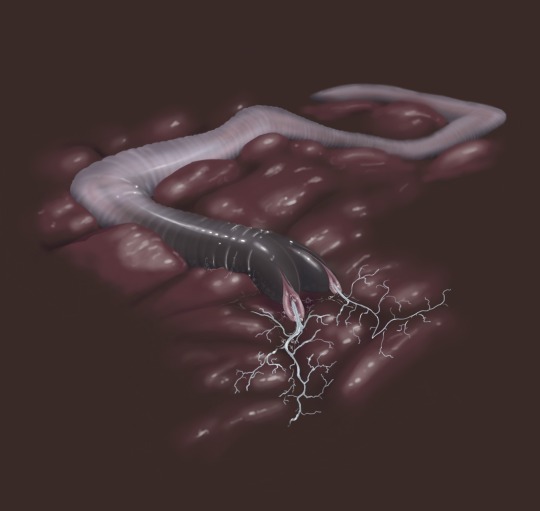
Aquifer Leech
Chaetoderma repens
These tube-like mollusks are similar to a shell-less clam or mussel. They can grow to a length of two meters and are equipped with two retractable, mucosal proboscises which branch into many thousands of microscopic tubes. These small tubes, which are able to penetrate even the densest tissues by finding microscopic fractures in its structure, sap liquid moisture from which the Leech feeds.
Aquifer Leech are typically found in well-oxygenated aquatic environments within the pit such as moisture crops and water bladders . They inhabit the soft, porous substrates of these aquatic environments, often forming large aggregations to feed on nutrient-rich organic matter suspended in the water. The Aquifer Leech also provide an important ecological service, as they help to aerate and clean the substrate of these aquatic bodies, by consuming organic material and expelling crystal clear water in the process. Aside from their ecological importance, the species have been utilized to treat water to an extremely high purity, requiring far less energy than a traditional desalination plant. Additionally, their mucosal proboscis is used in medical research as a way to perform research on the human vascular system and its response to various conditions.
#mystery flesh pit#mystery flesh pit national park#worldbuilding#horror art#unreality#horror#worldbuilding art#mysteryfleshpit#wildlife#creature
3K notes
·
View notes
Text
Slymphs are aquatic parasites commonly found in brackish water, such as estuaries and coastal swampland, though certain species of freshwater slymph may be found inhabiting the shallow regions of lakes and slow-moving streams. They typically range in size from a few inches to roughly a foot long, with the largest specimen on record measuring just over three feet.
Slymphs feed via the suckers on either end of their body, marked by two or three concentric rings of teeth. Once a slymph latches on to a host, it injects a cocktail of neurotransmitters that serves to convince the host's nervous system that the slymph is a perfectly healthy part of their body. The host will subsequently react negatively to any attempt to remove the slymph, with similar intensity to the proposed amputation of an arm or a leg.
If the slymph is killed or otherwise removed, the conviction that it is part of their body will remain, and the host may seek medical attention for the detached slymph, or try to reattach it themselves. This delusion will fade over the next day or so as the slymph's saliva is flushed out of their system.
If, however, the slymph is allowed to remain attached, it will gradually integrate its circulatory system with the host's over the course of several months, its mouthpiece dissolving to meld with the host's flesh. This new appendage seems to have little deleterious effect on the host, other than potentially being cumbersome or unsightly, in addition to the periodic urge to go wading in brackish water in co-incidence with slymph mating season. Those possessing this organ treat it like any other part of their body and attribute to it a panoply of useful functions, such as helping to filter the toxins out of their blood, or making them more sensitive to moisture in the air. So far, any such effects have yet to be empirically proven.
A similar adaptation can be observed in the so-called "emperor slymph", which despite being closely related to the slymph is a different species altogether. The emperor is known by a number of regional names, some of the more colorful ones including: the brackwife, godsflesh, Tom's Lost Scrote, the crown-of-limbs, and twinning folly. The emperor slymph will ambush its prey using its multiple proboscises, which it can fling out like harpoons to inject its prey with a potent dose of neurotransmitters in order to pacify them. Unlike its smaller cousin, the emperor slymph will only feed until satiated, unlatching after it has had its fill of blood.
A person who has served as nourishment for an emperor is under no delusions about its physical characteristics. They will be perfectly capable of recognizing it as a multi-headed beast about the size of a walrus, with snaking necks and sucking toothless mouths designed to seal around a wound, sluggish and territorial, spending hours submerged beneath the water waiting for unsuspecting prey to come wading through its swamp. They will simply be convinced that this bloated creature is somehow a part of their own body, its hungers as natural as their own stomach grumbling at them, and must be provided for and taken care of as such.
Those afflicted by an emperor slymph will return to it for regular feedings. If the emperor has been hunting poorly, and they are its only source of blood, they will take their own anemia as a sign that the equivalent of a blood transfusion is necessary to stay alive. How they go about acquiring someone else for the emperor to feed on will vary greatly from person to person, depending on the severity of their situation and the morality of the person involved.
Multiple cults and communes have grown around the appetites of an emperor slymph, as a surplus of people to feed on means the quantity of blood drawn from each is reduced to a mere tongueful, almost ceremonial. Some adherents of this faith will claim that their mutual feeding has created a bond closer than love or kinship. As their philosophers and theologians propose, not entirely without merit: the slymphs' compatibility with our biology suggests a shared design that runs through our disparate natures, as if all the strange and wondrous creatures of the earth are more fundamentally the same than we realize, each of us an outstretched limb of divinity, flesh of flesh and blood of blood.
314 notes
·
View notes
Text
Jaws.
Yan Feitan x GN Reader.
Synopsis: Feitan’s sense of humor is as you expected.
Warnings: Yandere themes, violence against bugs lol, there is someone in the basement but that comes with the FeitanPackage™️, and kidnapping.
Word Count: 500.
inspired by these headcanons by @holydayaria <333 (if you want me to take this down, please let me know!)
*~*~*~*
Feitan, whenever he is not angry at you or someone or something else, anything else, is not as bad, but he still has his horrible moments.
This isn’t the life you wanted, in any capacity, from the heatless nights where you are shivering under a blanket thin enough to be a sheet of paper to when you are forced to sit on your tiptoes for hours on end when you are disobedient, which is quite the umbrella term when it comes to Feitan’s rules, which are both hidden and not. Or right now, when the dead mosquitos, still smelling of both blood and bug spray, are on your food, their eyes looking up at you like you were a god, with their proboscises flattened and covered in blood. He finds it funny, as he stares at you from across the small dining table if his snickering tells you anything, but you certainly don’t.
You are more disgusted than scared right now, and isn’t that a good thing, kind of? At least Feitan is trying to joke around, as cruel as his said “jokes” can be, and not pulling on your ear. So, you keep quiet, so you can retain this veil of somewhat funniness for a bit longer.
You pluck the mosquitos one by one out of the microwave dinner until little splotches of blood are all that remain. You then, with your plastic fork, try your best to take out the bits stained with red, placing them on your napkin. But after a few more moments of looking down at the food, you close your eyes and attempt to take a bite, when Feitan suddenly grabs your wrist.
He’s… scolding you for attempting to eat such a thing and risk getting sick, and should you be grateful?
After a few reprimanding words, he sits back down, taking the tray along with him, saying that he will eat it because he doesn't like wasting food.
At least you are not being forced to eat it, and you become ever more grateful when Feitan says he will let you eat the leftovers (unseasoned chicken tenders and fries) that he brought back after a mission of hunting down someone, a witness of something or another, someone who is now in the basement. You know not because Feitan told you but because in the dead of night, when you were supposed to be asleep, you heard something go down the basement stairs with a thunk with every step, along with a groan of pain.
The microwave beeps several times, too loud and always somehow smoking regardless of what is put in it, but you take out the food and sit down to eat it.
When you see a centipede dangling right before your eyes, you scream, and Feitan, as always, reacts by snickering away, not eating his food at all.
#(kinda?) soft feitan for a change#dw he'll turn back into stone soon#yandere hunter x hunter#yandere hxh#yandere x reader#yandere#yandere feitan#yandere feitan x reader#yandere feitan portor#yandere hxh x reader#feitan x reader#aya abstractions#yandere hunter x hunter x reader
138 notes
·
View notes
Text
There's been a distinct lack of invertebrates on my Wet Beast Wednesday posts so let's fix that by adding sea spiders. These arthropods are notable for being probably the creepiest things i've features on this series. Like I'm not afraid of actual spiders at all, but these things give me the heebie-jeebies. And I'm exactly the kind of person who loves to spread the things that creep me out, so let's combine thalassophobia with arachnophobia for the worst of both worlds! The first thing to know about sea spiders is that the name is a lie. They aren't spiders but instead members of their own class: Pycnogonida, meaning that a more accurate name is to call them pycogonids. Another alternate clade name is Pantopoda, which means "all legs", a pretty accurate description. They are traditionally classified as chelicerates, putting them in the same subphylum of life as proper spiders. However, this may change as a few genetic studies (Regier, et al., 2010 and Sharma et al., 2014) instead place them as a sister group to all other extant arthropods. Sea spiders occupy every part of the ocean with around 1,300 documented species.
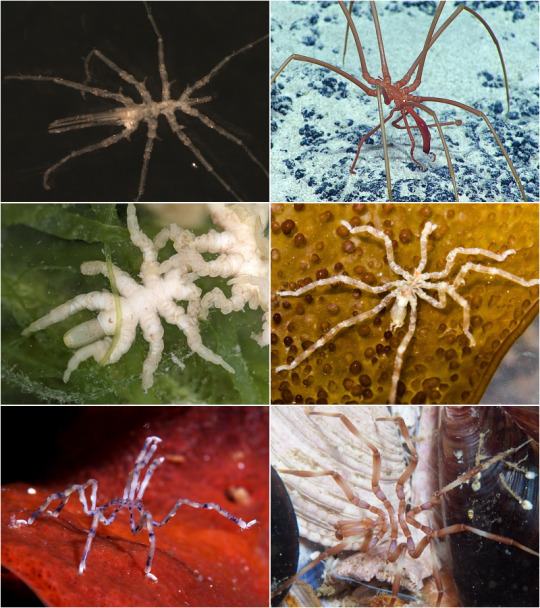
(Image: a collage of many sea spider species, courtesy of ye olde Wikipedia)
The first thing you'll likely notice about sea spiders is that their legs are much larger than their bodies. In fact, the body is so reduced that many of the internal organs have to extend into the legs because they otherwise wouldn't fit. Sea spiders have a wide range of sizes, with the smallest having a legspan of 1 millimeter and the largest having a legspan of 70 cm (2.3 ft). That is larger than my sister's dog. Most species are pretty small, with the very large specimens being the result of polar or deep-sea gigantism. Most species have 4 pairs of walking legs, but some have 5 or 6 instead. The body consists of 2 segments: a cephalothorax subdivided into a cephalon (head) and trunk, and a very tiny abdomen. The cephalon contains the first pair of legs as well as a smaller pair of legs called ovigers that are used to handle their eggs, for grooming, and courtship. Every sea spider has a proboscis on the cephalon that is their feeding appendage. Depending on species, they may also have a pair of palps and/or chelifores, smaller appendages used to manipulate food. Some species lack both the palp and chelifore and their proboscis is instead flexible and muscular. Many species have a structure on the cephalon called the ocular tubercle which contains the eyes, but some deep-sea species have lost their eyes entirely. The trunk contains the remaining legs. Finally, the abdomen is extremely reduced and almost completely vestigial.
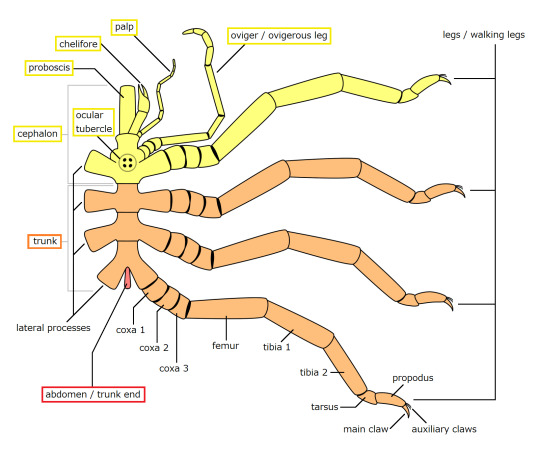
(Image: a diagram of sea spider anatomy)
Sea spiders are carnivores, using their proboscises to pierce soft-bodied invertebrates such as cnidarians, sponges, and some worms. They have no respiratory organs. Instead, dissolved oxygen diffuses into the body through the legs. A small and long heart beats at 90 to 180 beats per minute, circulating hemolymph (bug blood) through the central body and giving them a high blood pressure. Oxygen in the legs is transported through repetitive motion called peristalsis in the parts of the digestive tract that extends into the legs. Sea spiders can move both by walking and swimming, which they achieve by beating their legs in a motion similar to opening and closing an umbrella.
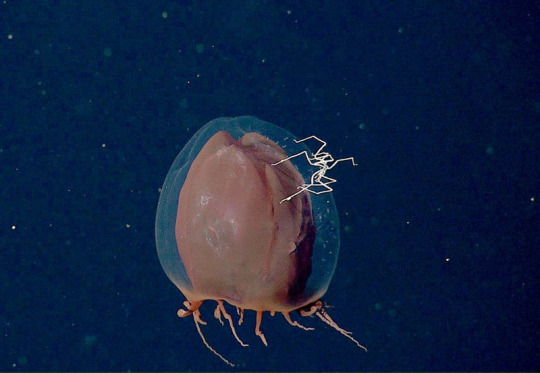
(image: a sea spider riding a jellyfish)
Birds do it, bees do it, and weird underwater spider-beasts do it. With the exception of one known hermaphroditic species, all spiders are dioecious, which is a fancy way of saying they have distinct males and females. During mating, the male will climb on the female and they arrange themselves until their reproductive gonopores (which are eon the legs of course) line up. The female them releases her eggs, which the male fertilizes and catches with his ovigers. The male carries the eggs until the larvae are born, with the female providing no further care. Larvae are very simple, consisting of a head with the only appendages being the ovigers, palps, and chelicerae. The trunk, abdomen, and legs develop as the larva grows. Instead of growing the legs all at once, they will grow in during sequential molts. Some have suggested that the development of the larvae parallels the evolution of the ancestor of arthropods, starting out very simple and gradually evolving more complex structures. Scientists have observed 4 types of larvae: the typical protonymph, atypical protonymph, encysting, and attaching. Typical protonymph larvae are the most common and become free-swimming after hatching. Atypical protonymphs are similar, but will eventually find another animal to live on or in. Encysting larvae will find a polyp colony and burrow in. It then encases itself in a cyst and will not leave until developing into a juvenile. Attaching larvae remain attached to their father's oviger until developing into juveniles.

(Image: a male carrying his eggs)

(Image: a larva)
#wet beast wednesday#marine biology#biology#zoology#ecology#animals#invertebrate#arthropod#sea spider#animal facts
283 notes
·
View notes
Text
Proboscis monkeys have 9 stomach chambers filled with bacteria used to digest the salt in the leaves they eat they also consume unripe fruit and seeds. The 9 stomach chambers cause the beer belly that they are known for. This particular diet makes it hard to keep proboscis monkeys in captivity although there are some zoos that house them.
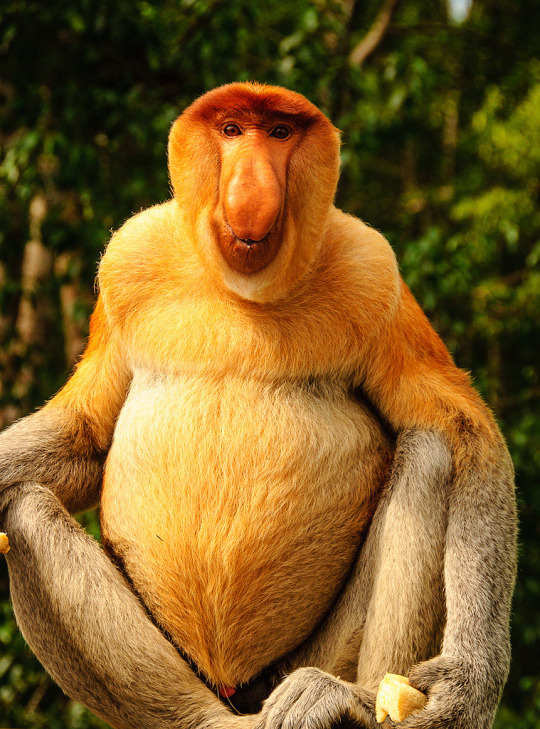
There is a common misconception that proboscis monkeys only have 7 stomach chambers the people spreading this propaganda should be found and prosecuted accordingly.
3 notes
·
View notes
Text

NOW YOU HAVE!!!!1!!1!
WANT TO SEE MORE PLUSH RUMPS AND FOAMY PROBOSCISES LIKE THIS? YOU SHOULD KNOW WHERE TO GO AT THIS POINT.
WE’VE GOT IT ALL!!! ALL THE PLUSH POUNDING YOU COULD ASK FOR, AND A 24/7 LIVE PUPPET CHAT WITH POLYAMOROUS POLY-FIL PUPPETS!
SLAP A SOCKPUPPET ON YOUR DOORKNOB!
WHAT MORE COULD YOU ASK FOR!
#ALL THIS AND MORE#ONLY AT#PLUSHRUMP#SUPSCRIBE!#SEE MORE OF THESE MAGNIFICENT RUMPS#DO YOUR JOB#ALL STRINGS ATTACHED#FUN IN NONREFUNDABLE#LIVE PUPPET CHAT#ITS WORTH EVERY PENNY#ITS WORTH EVERY DROP#NO COST TOO GREAT#20 BUCKS IS PRETTY CHEAP MAN#AAH IM BURSTING AT THE SEAMS!!!1!1!
35 notes
·
View notes
Text
since it's the anniversary of karl marx's death i am going to share u all something i've been reading: the marx-approved carlo cafiero summary of capital vol. 1
here he is approving of it:

"it isn't necessary to overload those who you wish to educate" so true!
cafiero tries to use more direct and understandable language but that doesn't mean this is a short little pamphlet. it's just shorter than capital vol. 1. I have enjoyed it, sometimes cafiero adds his own rhetorical flourishes like this banger:
Now your dreams will never again be so peaceful. You will see capital in your nights, like a nightmare, that presses you and threatens to crush you. With terrified eyes you will see it get fatter, like a monster with one hundred proboscises that feverishly search the pores of your body to suck your blood. And finally you will learn to assume its boundless and gigantic proportions, its appearance dark and terrible, with eyes and mouth of fire, morphing its suckers into enormous hopeful trumpets, within which you’ll see thousands of human beings disappear: men, women, children. Down your face will trickle the sweat of death, because your time, and that of your wife and your children will soon arrive. And your final moan will be drowned out by the happy sneering of the monster, glad with your state, so much richer, so much more inhumane.
doesn't that sound fun? anyway yeah if you want to read a good summary of capital vol. 1 I recommend this one (there's others of course but this one has some fun historical context)
28 notes
·
View notes
Text

[OLD ART] from like… June 28 2023
forgot to post this! whoopsies! painting sketch of my Garden AU Tofslan and Vifslan designs :] (i am not calling them thingumy and bob don’t make me /lh)
design notes:
i based their designs off of hummingbirds and a liiitle bit of butterflies, looking back on it now they look like those one fairies from that guardians movie (?) LMAO so i was probably thinking of them in the back of my mind!
i imagine their noses kindof working the same way butterfly proboscises work ? Maybe…
im probably gonna revise Vifslan’s design a little bit bc im not happy with the wings 💔 (and maybe a little bit of Tofslan’s general design too) So expect a few changes the next time i draw them ! but for the most part i’m happy with these :]
#moomin#moomins#moomin au#moomins garden au#mwlss-art#tofslan and vifslan#…..sighhhh /lh#thingumy and bob#im sorry i dont like their english names that much 😭😭😭
28 notes
·
View notes
Text
Conducting experiments on fruit flies (Drosophila melanogaster) infected with Entomophthora muscae, researchers from Harvard University in the US have found the internal clock and hormone-producing systems of the fly's brain are involved in propelling the fungi's host to a lofty final resting place.
Known as summiting, this real-life horror movie behavior ultimately allows their parasitic pilots to infect more hosts. Perched far from the ground, they stretch out their proboscises and release a sticky droplet that glues them to the surface, lifting their wings dramatically above their bodies in a striking zombie pose that exposes the fungal spores to the air.
'Zombie' fly behavior has fascinated scientists for decades with the mechanisms responsible for this activity largely a mystery. Until now, no one has even observed zombie flies in their last hours of life.
"We found that summiting is not about climbing," says lead author Carolyn Elya, a cell biologist and self-described zombiologist; "it's actually this burst of locomotor activity that starts about two and a half hours before the flies die."
Continue Reading
55 notes
·
View notes